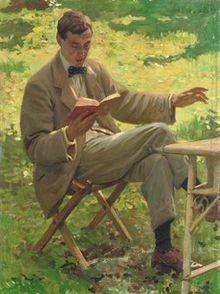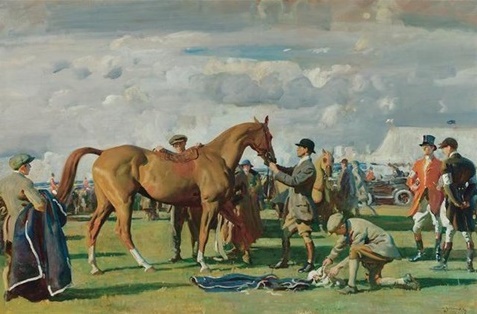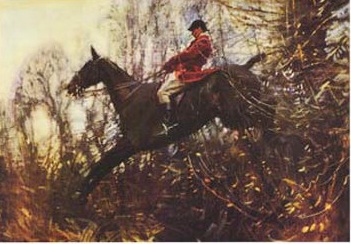|

by Harold Knight Secret portrait of British artist hidden behind another canvas by admirer
Sir Alfred James Munnings KCVO, PRA (8 October 1878-17 July 1959) was known as one of England's finest painters of horses, and as an outspoken enemy of Modernism. Engaged by Lord Beaverbrook's Canadian War Memorials Fund, he earned several prestigious commissions after the Great War that made him wealthy.
Biography
Alfred Munnings was born 8 October 1878 at Mendham, Suffolk across the River Waveney from Harleston in Norfolk. At fourteen he was apprenticed to a Norwich printer, designing and drawing advertising posters for the next six years, attending the Norwich School of Art in his spare time. When his apprenticeship ended, he became a full time painter. The loss of sight in his right eye in an accident in 1898 did not deflect his determination to paint, and in 1899 two of his pictures were shown at the Royal Academy Summer Exhibition. He painted rural scenes, frequently of subjects such as Gypsies and horses.

Horses and Gypsy Caravans He was associated with the Newlyn School of Painters.
Munnings career would be associated with equine painting. He used his art to depict horses involving in hunting and he painted racehorses.
Although he volunteered to join the Army, he was assessed as unfit to fight. In 1917, his participation in the war was limited to a civilian job outside of Reading, processing tens of thousands of Canadian horses en route to France-and often death. Later, he was assigned to one of the horse remount depots on the Western Front.
Munnings' talent was employed as war artist to the Canadian Cavalry Brigade under the patronage of Max Aitken in the latter part of the war. During the war he painted many scenes, including a mounted portrait of General Jack Seely Warrior in 1918 (now in the collection of the National Gallery of Canada, Ottawa). Munnings worked on this canvas a few thousand yards from the German front lines. When General Seely's unit was forced into a hasty withdrawal, the artist discovered what it was like to come under shellfire.
Munnings also painted Charge of Flowerdew's Squadron in 1918 (now in the collection of the Canadian War Museum, Ottawa). In what is known as "the last great cavalry charge" at the Battle of Moreuil Wood, Gordon Flowerdew was posthumously awarded the Victoria Cross for leading Lord Strathcona's Horse (Royal Canadians) in a successful engagement with entrenched German forces.
...The Canadian Forestry Corps invited Munnings to tour their work camps, and he produced drawings, watercolors and paintings, including Draft Horses, Lumber Mill in the Forest of Dreux in France in 1918. This role of horses was critical and under-reported; and in fact, horse fodder was the single largest commodity shipped to the front by some countries.
The "Canadian War Records Exhibition" at the Royal Academy after war's end included forty-five of Munnings canvasses.
Munnings was elected president of the Royal Academy of Art in 1944, a post he held until 1949. His presidency is most famous for the departing speech he gave in 1949, attacking modernism. The broadcast was heard by millions of listeners to BBC radio. An evidently inebriated Munnings claimed that the work of Cézanne, Matisse and Picasso had corrupted art. He recalled that Winston Churchill had once said to him, "Alfred, if you met Picasso coming down the street would you join with me in kicking his...something?" to which Munnings said he replied "Yes Sir, I would".
He was awarded a knighthood in 1944. He died at Castle House, Dedham, Essex, on 17 July 1959. After his death, his wife turned their home in Dedham into a museum of his work. The village pub in Mendham and a street is also named after him.
At Auction
His immensely popular sporting art works have enjoyed popularity in the United States as well as the United Kingdom and elsewhere. Represented by agents Frost & Reed of London while he was alive his works found homes in some of the wealthiest consumers of the day.
 The highest price to date (January 2007) of a Munnings painting was from a work held by The Greentree Foundation (the Collection of Mr. and Mrs. John Hay Whitney) at Sotheby's in New York City May 5, 2004. Lot 30, "The Red Prince Mare," sold for $7,848,000, far above his previous auction record of $4,292,500 set at Christie's in December, 1999. It was one of four works by Munnings in the auction. "The Red Prince Mare" is a 40-by-60-inch oil on canvas that was executed in 1921 and had an estimate of $4,000,000 to $6,000,000. The highest price to date (January 2007) of a Munnings painting was from a work held by The Greentree Foundation (the Collection of Mr. and Mrs. John Hay Whitney) at Sotheby's in New York City May 5, 2004. Lot 30, "The Red Prince Mare," sold for $7,848,000, far above his previous auction record of $4,292,500 set at Christie's in December, 1999. It was one of four works by Munnings in the auction. "The Red Prince Mare" is a 40-by-60-inch oil on canvas that was executed in 1921 and had an estimate of $4,000,000 to $6,000,000.

A Huntsman 
The Huntsman 
Stanley Barker and the Pytchley Hounds |